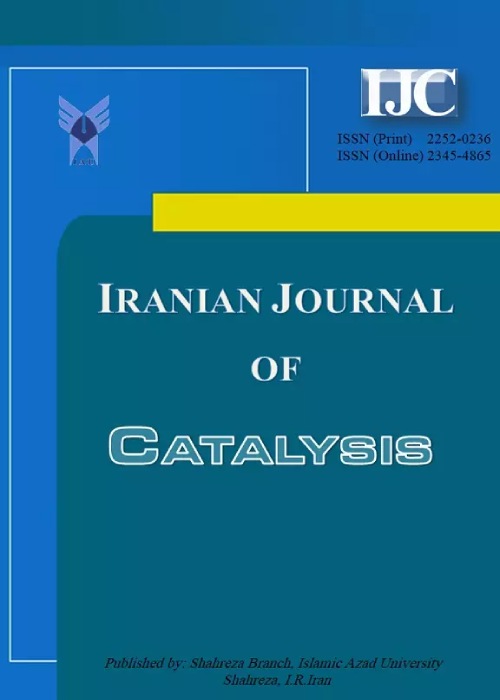فهرست مطالب

Iranian Journal of Catalysis
Volume:3 Issue: 1, Winter 2013
- تاریخ انتشار: 1392/03/20
- تعداد عناوین: 8
-
-
Page 11,2-Diketones have been reacted in one-pot method with 1,2-diamines at room temperature with ZnO nanoparticles as a catalyst. ZnO nanoparticles as an available and reusable catalyst is used for the synthesis of Quinoxalinein improved yields.Keywords: Quinoxaline, ZnO nanoparticles, Solvent free, Benzil, 1, 2, Diamines
-
Page 9The aryl-(Z)-N-[2-amino-1,2-dicyanovinyl]formamidine 2 cyclize in solvent-free conditions and in the presence of a base to give a 5-amino-1-aryl-4-cyanoimidazoles 3. Silica sulfuric acid as an efficient and reusable heterogeneous catalyst has been used for the preparation of amidines 2 from formimidate 1 through reaction with aromatic amines at room temperature and in good to excellent yields. All these derivatives were fully characterized by spectroscopic data.Keywords: Silica sulfuric acid, Heterogeneous catalyst, Imidate, Amidine, Aiaminomaleonitrile, Cyanoimidazole
-
Page 15A highly practical and efficient preparation of pyrano[3,2-c]pyridone and pyrano[3,2-c]quinoline derivatives was developed via an ionic liquid mediated and promoted multi-component reaction of malononitrile, aldehyde, and 4-hydroxyquinolin-2(1H)-one or 4-hydroxy-6-methylpyridin-2(1H)-one. The combinatorial syntheses were achieved for the first time without applying extra activation energy at ambient temperature while making use of [BMIm]Cl as a catalyst solvent.Keywords: Aldehydes, Ionic liquid, Catalyst, 1, 3, dicarbonyl compounds
-
Page 21A simple, novel, efficient and three-component procedure for the synthesis of pyrimido[4,5-d]pyrimidine-2,4-dione derivatives by the reaction of 6-amino-1,3-dimethyluracil, aldehyde and 2-benzylisothiourea hydrochloride promoted by ionic liquid 1-butyl-3-methylimidazolium bromide ([BMIm]Br) under solvent-free conditions is reported. The presented method is benefited from operational simplicity, simple workup and reusability of ionic liquid. These products were evaluated in vitro for their antibacterial activities.Keywords: Ionic liquid, Pyrimido[4, 5, d]pyrimidine, 2, 4, dione, 6, Amino, uracil, Antibacterial activities
-
Page 27Nano silica-H2SO4 is an efficient and mild catalysis system for the regeneration of aldehyde from aldoximes. Ketoximes are converted to amides by Beckmann rearrangement in the presence of nano silica-H2SO4. The reactions are carried out in solvent-free conditions under microwave irradiation (600 W) within 50-120 sec in good yields.Keywords: Oxime, Nano SiO2, Amide, Carbonyl compound
-
Page 33An efficient synthesis of 2,4,5-trisubstituted and 1,2,4,5-tetrasubstituted imidazoles by one-step condensation of an aldehyde, benzil, ammonium acetate and primary amine in the presence of nanocrystalline magnesium aluminate under microwave irradiation is described. The advantages of this catalyst are including simple work-up, low cost and reusability. Compared with conventional methods, the main advantages of the present procedure are its being a green method, its milder conditions, necessary shorter reaction time, and its higher yields and its selectivity. The structures of products were characterized by 1H NMR, 13C NMR, IR, elemental analyses, MS and UV spectral data. Their melting points were compared with literature report.Keywords: Nanocrystalline magnesium aluminate, Imidazoles, Solvent free, MW irradiation, Multi, component reaction
-
Page 41A series of 2-amino pyridine-3-carbinitrile derivatives incorporated coumarin moiety has developed via multicomponent condensation of 3-acetyl-2H-chromen-2-one, arylaldehydes, malononitrile and ammonium acetate utilizing Brønsted acidic ionic liquid, (4-sulfobutyl)tris(4-sulfophenyl)phosphonium hydrogen sulfate as catalyst under solvent-free conditions. Good yields, short reaction times, straight forward workup, reusability of the ionic liquid and green conditions are the most obvious advantages of this methodology.Keywords: 2, Amino pyridine, 3, carbinitrile, Multicomponent condensation, 3, Acetyl, 2H, chromen, 2, ones, (4, Sulfobutyl)tris, (4, sulfophenyl)phosphonium hydrogen sulfate
-
Page 49Palladium (II) coordination complexes catalyze the reaction of alcohols with ketones to yield ethers. During the catalytic cycle, the alcohol adds selectively to the β-carbon (anti-Markovnikov). In this work, mechanism and kinetics for the reaction of methanol with methyl vinyl ketone (MVK), being catalyzed by Pd, has been theoretically investigated in detail. Using quantum mechanical approach, different probabilities were investigated and ultimately a model was presented in which an enol form is produced in the rate determining step and in continuation is converted into keto form. Considering the solvent effects, the activation energy and the change in Gibbs free energy for the formation of the activated complex for the rate determining step were calculated, which are in good agreement with the experimental value. The evaluation of keto-enol equilibrium constant also showed that the keto form is much more stable than the enol form.Keywords: Hydromthooxylation, Palladium, Density functional theory, Keto, enol tautomerization


